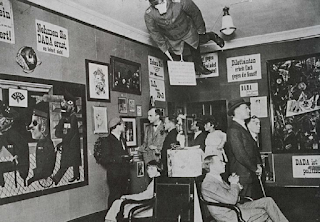Art and Anarchism 4.0: DADA
In the words of Hans Arp, “In Zurich, not involved in the slaughterhouses of the world war, we dedicated ourselves to the fine arts. While in the distance gunfire rumbled, we glued paper, read our works, wrote poetry, and sang at the top of our voices.” Dada was a direct response to WW1 and Dada Manifesto, was a massive critique of whatever artistic, social, or political values resulted in the war.
In 1915 Hugo Ball and his companion Emmy Hennings set up the Cabaret Voltaire, and were joined by other artists like Tristan Tzara, Marcel Janco, both of Romanian origin, Richard Huelsenbeck and Jean Arp, from France and Germany. They looked for radical criticisms of present society and the art that it produced.
“We know what Dadaism had done with politics, it had destroyed it with a stroke of the pen, ignored it. The movement revolted against power of all sorts,in favor of liberties of all sorts”, wrote the Dadaist Georges Ribemont-Dessaignes.
In actual fact, many of those involved in Dada had some knowledge of anarchism and were involved with it to a lesser or greater extent. Hugo Ball had translated Bakunin. Hans Richter had connections with the Zurich anarchist group and Tristan Tzara was to say “It is obvious that the anarchistic nature of Dadaism, together with the idea of a moral absolute that the movement placed beyond any practical contingency, was bound to keep the Dadaists away from political struggles”.
Tristan Tzara summed up the Dada attitude in the Dadaist Manifesto of 1918 : “Let everyone proclaim that we have a great work of destruction and negativity to accomplish. Sweep and clean. The cleansing of the fellow will take place after a period of total madness and aggression, the mark of a world left for too long in the hands of bandits who are tearing apart and destroying the centuries”.
For next week, I will be talking about the Russian Avant-garde.

Comments
Post a Comment